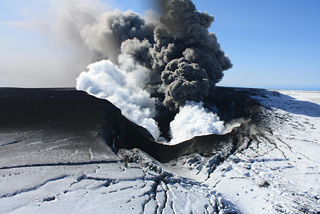|

Eyjafjallajokull on April 21.
Photo courtesy of the Institute of Earth Sciences
Nordic Volcanological Center. |
Some aircraft manufacturers have published
general guidance applicable to their fleets, and
ALPA expects others to do so in the near future.
This material is general and expands on that which
ALPA has released earlier this week. These general
guidelines, for both airborne and ground operations
are shown below, and in all cases, flight crews
should refer to their companys operating manuals
and follow published procedures. Remember, as Pilot
In Command, you are the final authority as to the
SAFE operation of your aircraft. Use all available
information and exercise your judgment and
authority.
1. Avoidance or immediate escape remains the
safest course of action:
Review all available information about volcanic
events and known ash sightings that could affect a
particular route. Update information during flight
when possible.
Remain upwind of volcanic ash and dust.
Remember that airborne weather radar is ineffective
in identifying ash.
Identify alternate and/or escape routes to
avoid/exit airspace containing volcanic ash. A
180-degree descending turn is recommended for
inadvertent encounter. Climbing out of the ash could
result in increased engine debris buildup leading to
damage or flameout.
2. Be alert for signs of inadvertent ash-cloud
penetration:
A
smoky or acrid odor like electrical smoke, burned
dust, or sulfur. Ensure that any electrical smell is
not due to actual electrical malfunctions.
Haze or dust inside the cabin.
Engine surging, torching from the tailpipe, or
flameouts. Engine temperatures can change
unexpectedly, and a white glow can appear at the
engine inlets.
If
volcanic ash fouls the pitot tube, the indicated
airspeed can decrease or fluctuate erratically.
Cabin pressure changes, including loss of cabin
pressurization.
Static discharges, similar to St. Elmos fire, or
glow outside of the windshield at wing leading edges
or engine inlets.
3. If ash penetration or contamination is
suspected:
Refer to the Volcanic Ash non-normal guidance in the
quick reference material.
Consider use of flight-deck oxygen at the 100
percent setting and manual deployment of the
passenger oxygen system.
Disengage autothrottle(s).
If
conditions allow, reduce thrust to idle immediately.
By reducing thrust, engines may suffer less buildup
of molten debris on turbine blades and hot-section
components. Idle thrust allows engines to continue
producing electrical power, bleed air for
pressurization, and hydraulic power for airplane
control.
Turn on continuous ignition, if available.
If
an engine flames out or stalls, attempt to restart.
During restart, the engines may take longer than
normal to reach idle thrust due to the combined
effects of high altitude and volcanic ash ingestion.
Flight crews should remember that the airplane may
be out of the airstart envelope if the encounter
occurs during cruise.
Turn on engine and wing anti-ice devices, and all
air conditioning packs. These actions improve the
engine stall margin by increasing the flow of bleed
air.
Start the Auxiliary Power Unit (APU), if available.
Flight crews should remember that multiple APU start
attempts can shorten battery life.
Monitor engine Exhaust Gas Temperature (EGT).
Because of potential engine debris buildup, the EGT
can climb excessively. The flight crew should
prevent EGT exceedances. Shut down the engine and
restart it if the EGT is approaching limits similar
to a hung start.
Monitor airspeed and pitch attitude. Watch for
abnormal indications from pitot static system
indicators. If necessary, follow the non-normal
checklist for flight with unreliable airspeed.
4. Ground Operations:
Ensure ash is removed prior to flight.
Ensure any material installed to protect against ash
is removed prior to flight.
Use
caution for ash-contaminated pavement during ground
operations.
ALPA will continue to maintain close contact with
manufacturers and regulators. Our members are
encouraged to check the website frequently for any
updates. We anticipate continued interest, by both
legislators and scientists, in the study of volcanic
ash, its effect on aircraft, and ways to predict
airborne hazards. ALPA will remain engaged in these discussions
with the goal of developing the most accurate
information possible for flight crew use.
See previous updates:
Volcanic Ash Update II, 4/21 |
Volcanic Ash Update, 4/19 |

